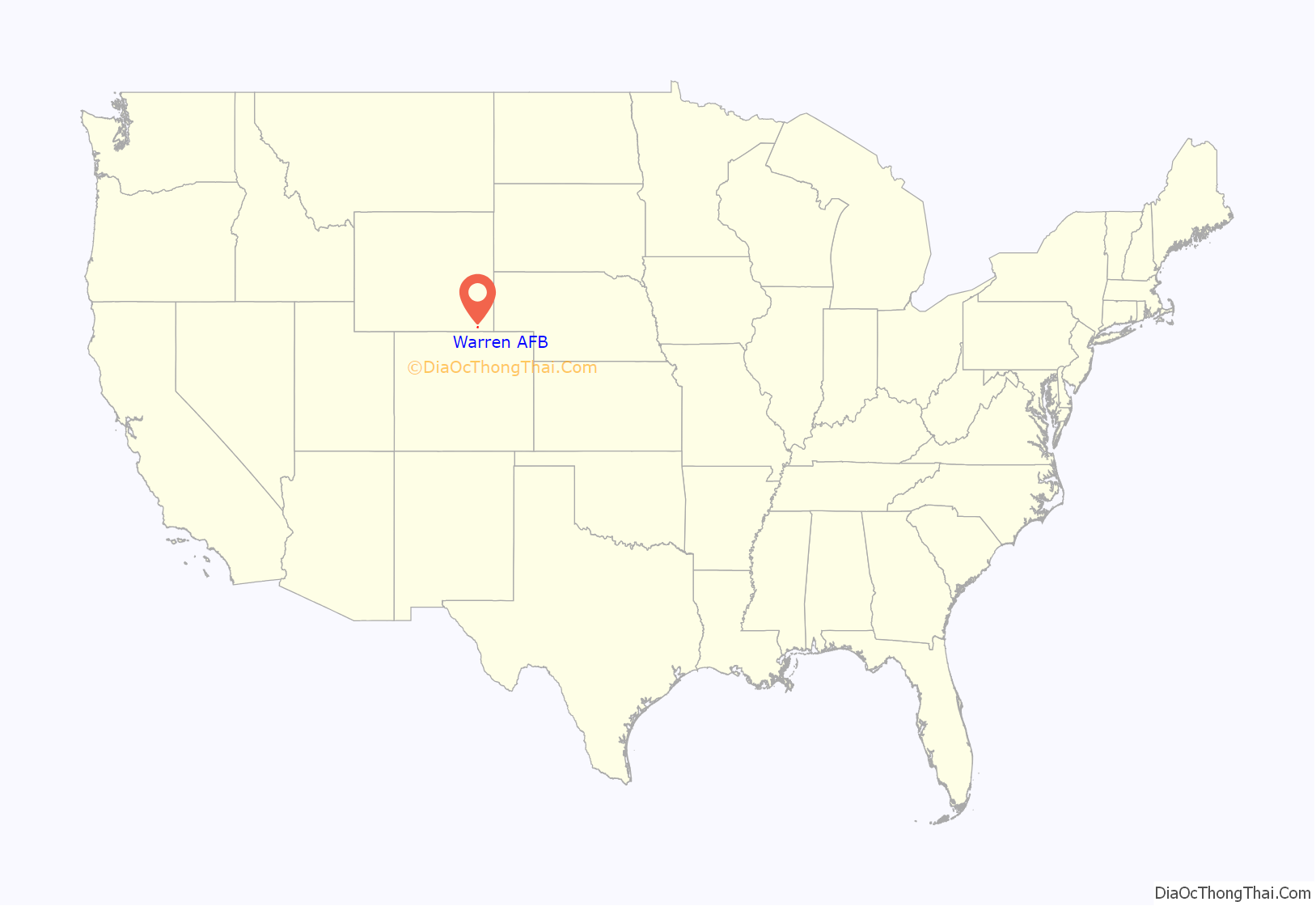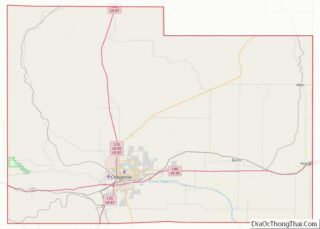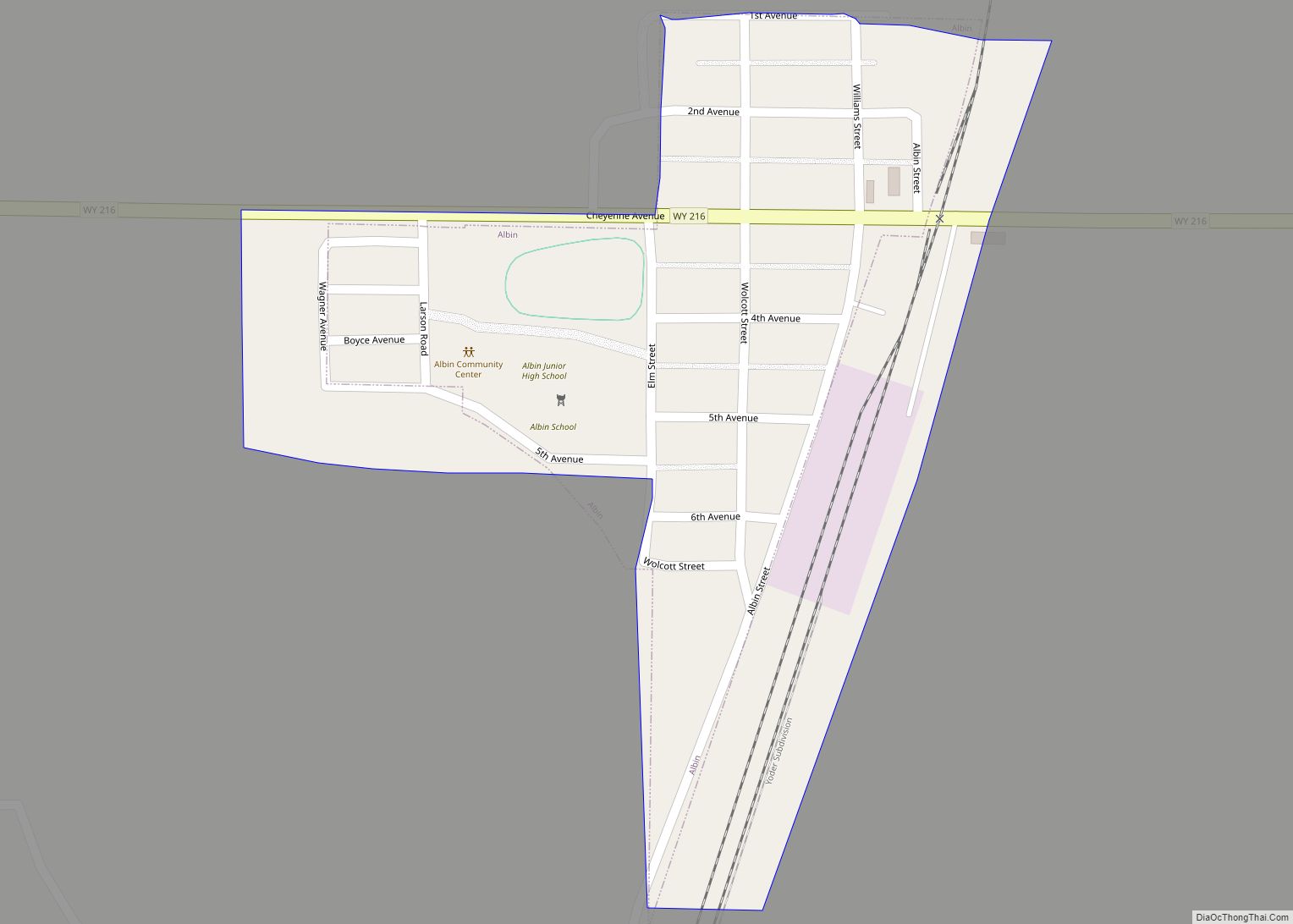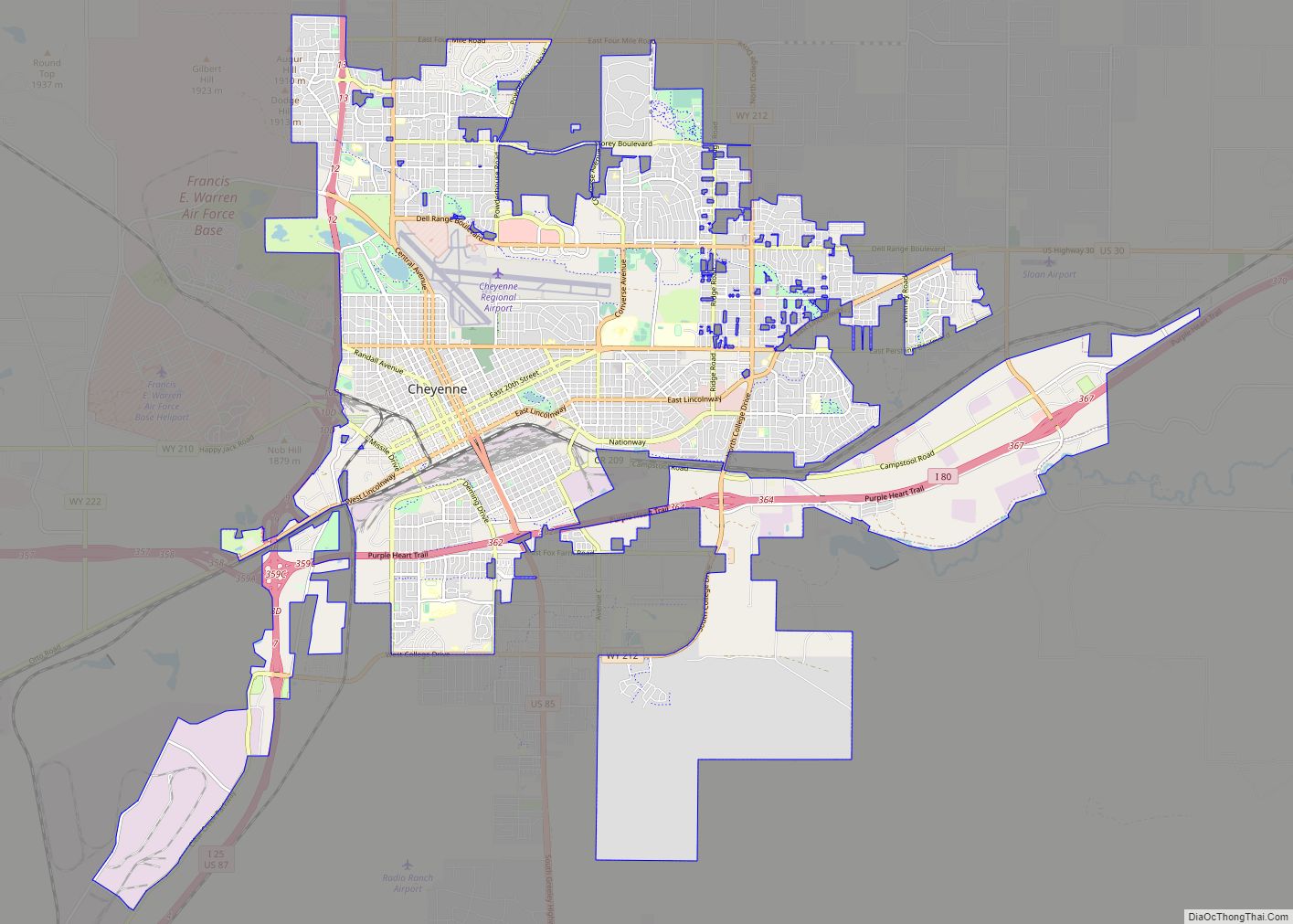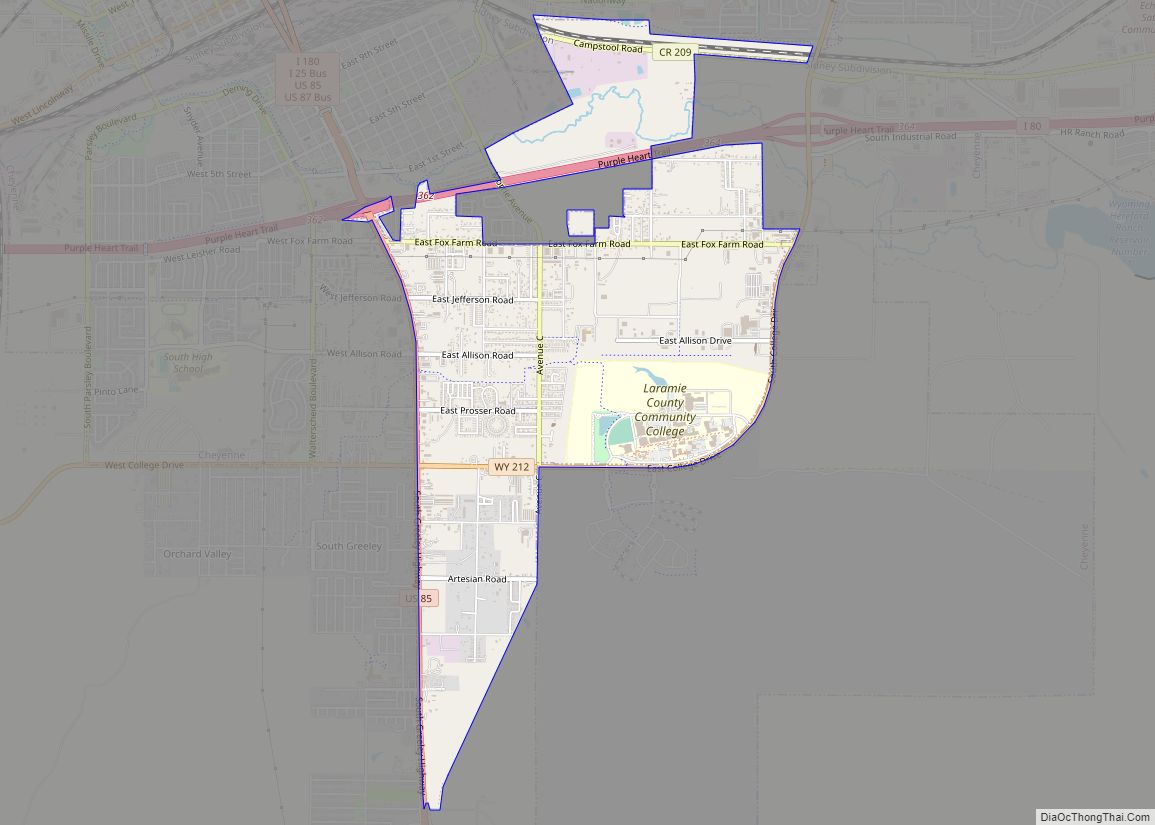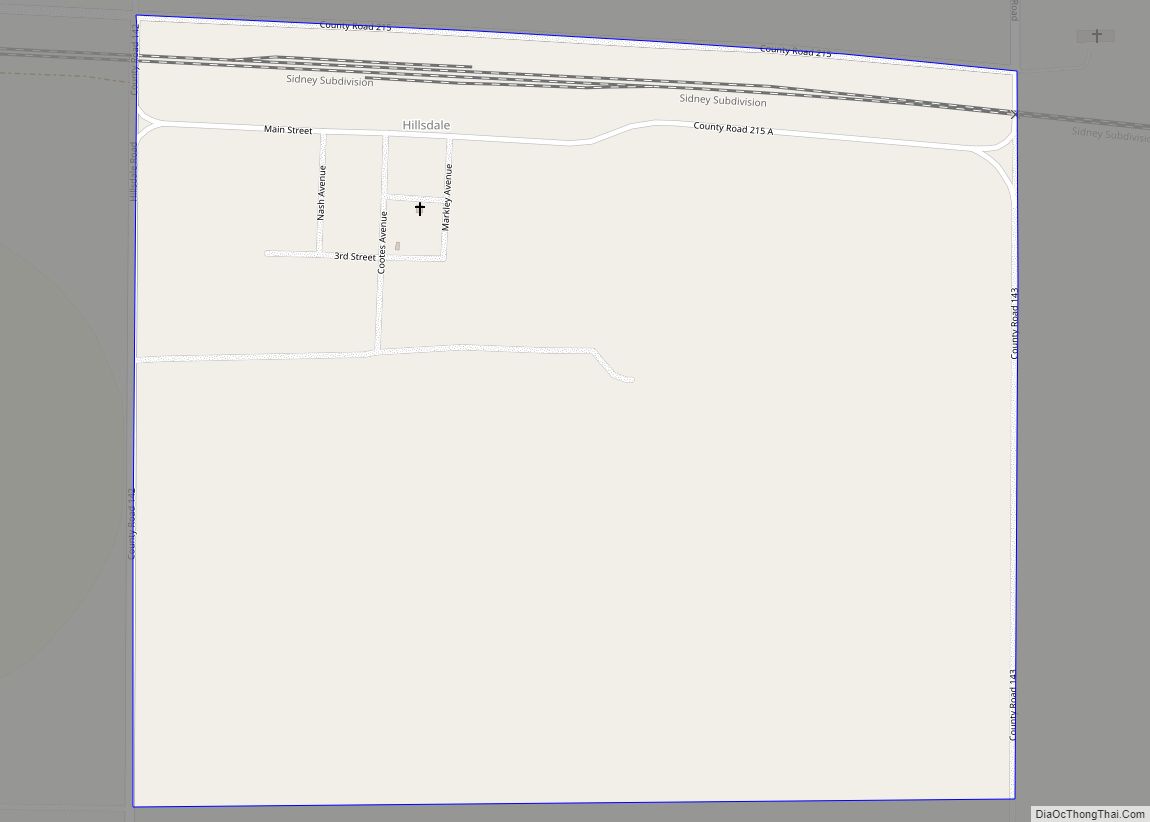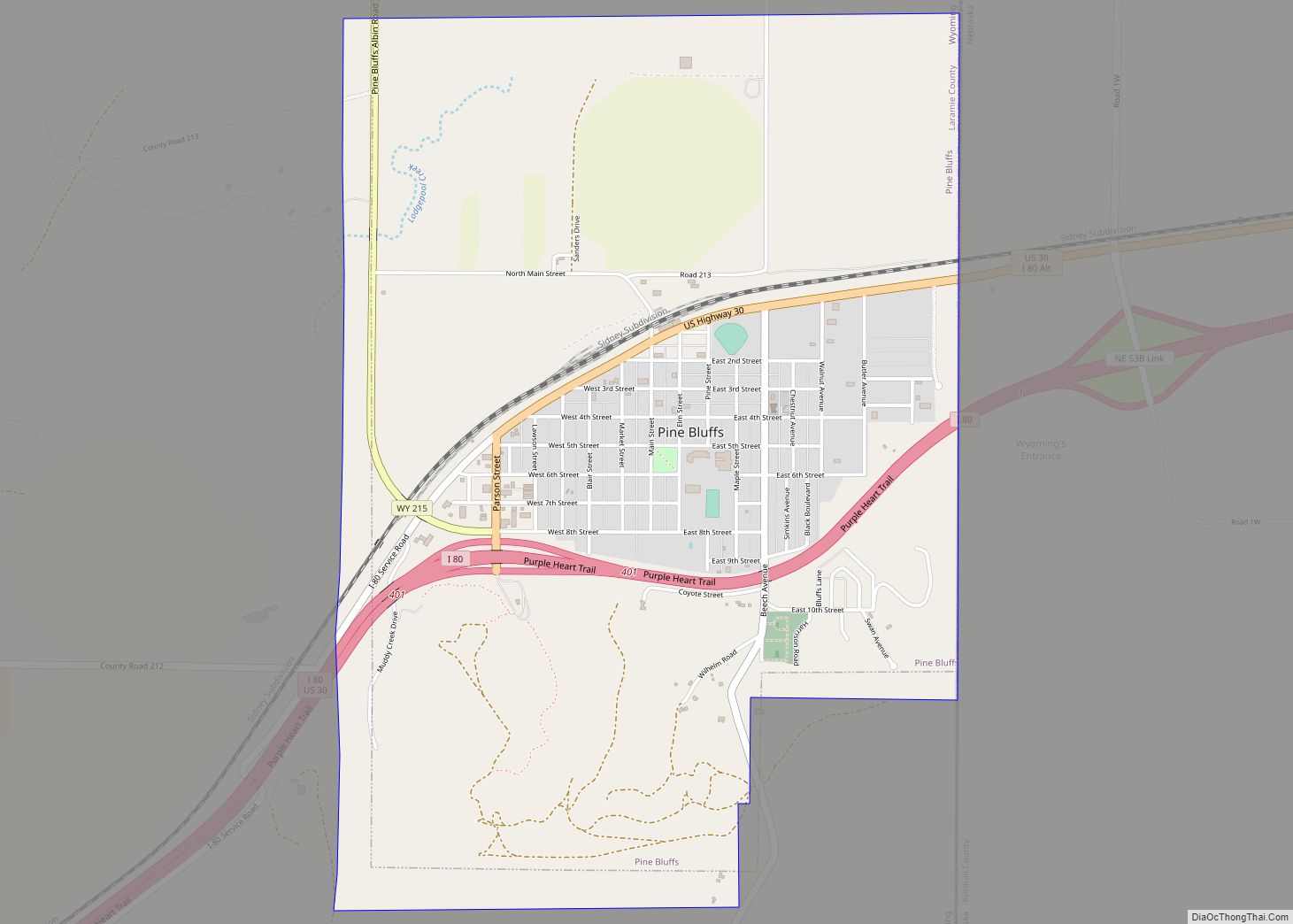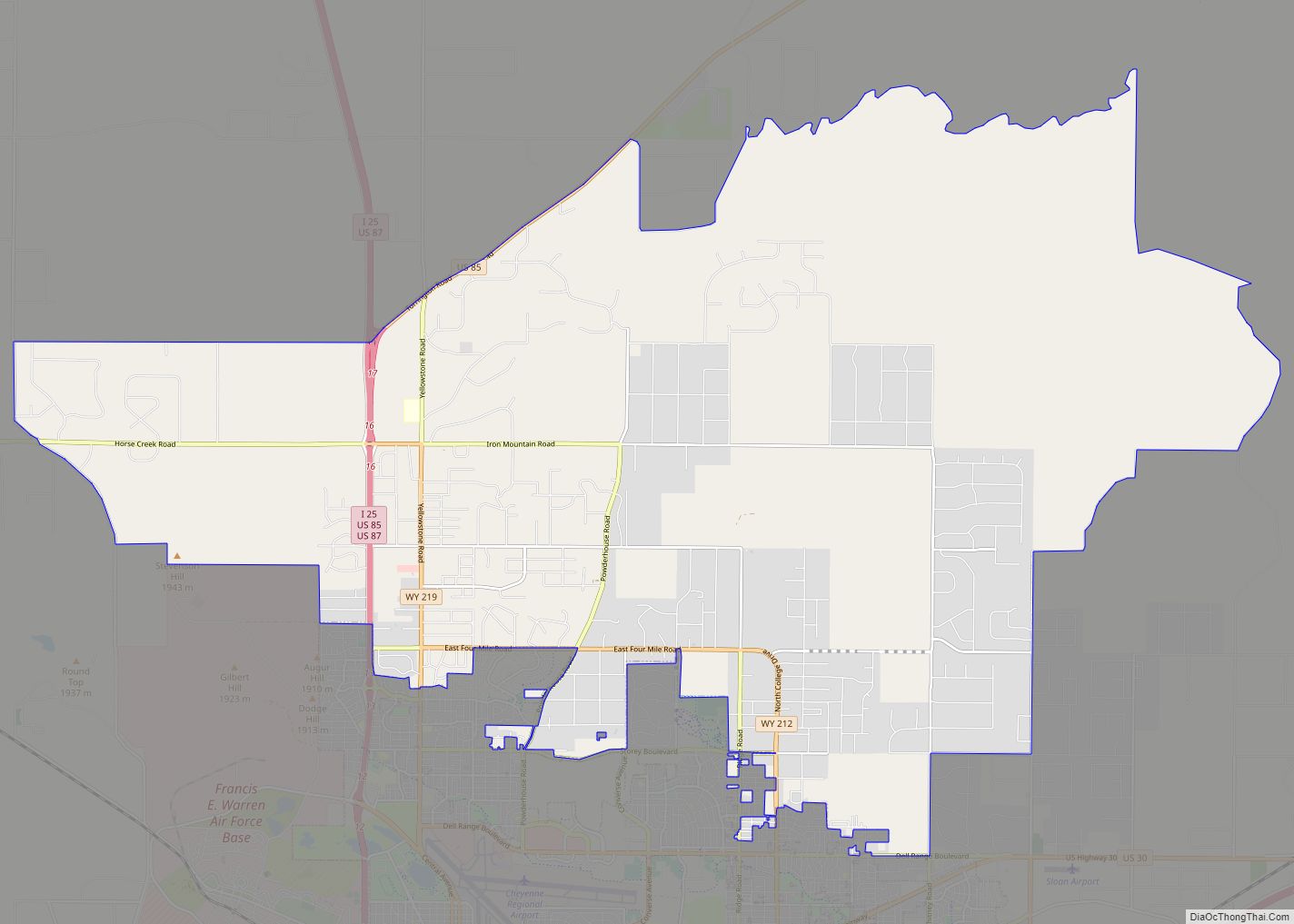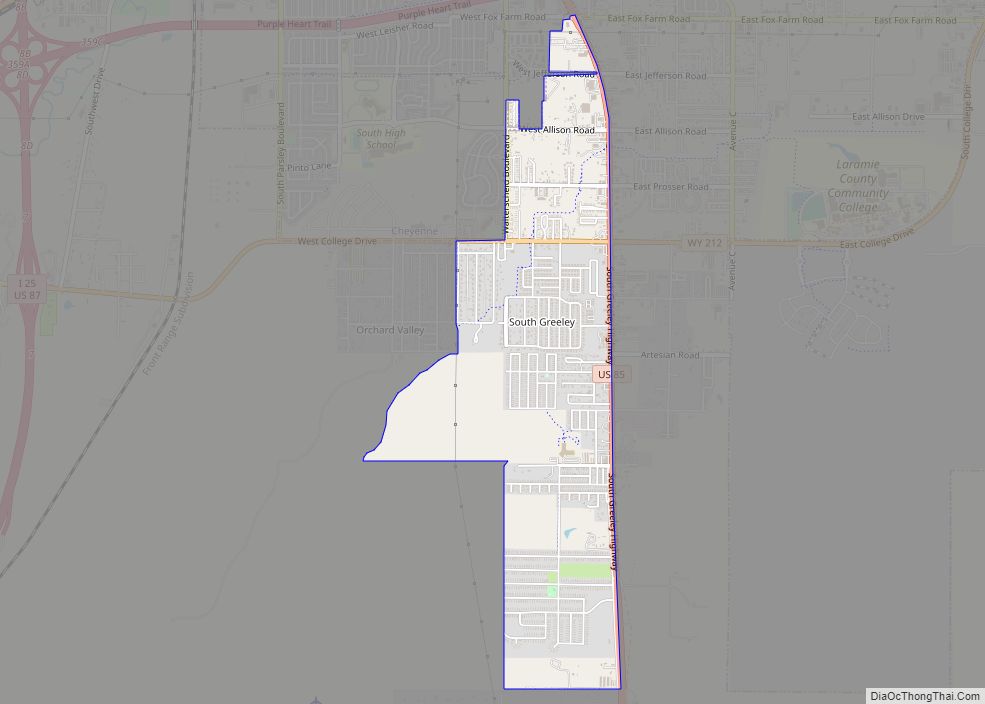Francis E. Warren Air Force Base (ICAO: KFEW, FAA LID: FEW), shortened as F.E. Warren AFB is a United States Air Force base (AFB) located approximately 3 miles (4.8 km) west of Cheyenne, Wyoming. It is one of three strategic-missile bases in the U.S. It was named in honor of Francis E. Warren in 1930. Warren AFB is home of the 90th Missile Wing (90 MW), assigned to the Twentieth Air Force, Air Force Global Strike Command. The 90 MW operates the LGM-30G Minuteman III ICBM. It is also the home of Twentieth Air Force, which commands all U.S. Air Force ICBMs.
Warren AFB is the oldest continuously active military installation within the Air Force, established in 1867 (156 years ago) by the United States Army as Fort David Allen Russell. The facility came under the control of the United States Army Air Forces on 1 June 1947, and then of the United States Air Force (USAF) on 18 September 1947.
The 90th Missile Wing is commanded by Colonel Catherine Barrington. Twentieth Air Force, co-located at Warren AFB, is under the command of Major General Michael Lutton. Warren AFB is a census-designated place and had a resident population of 3,072 at the 2010 census.
| Name: | Warren AFB CDP |
|---|---|
| LSAD Code: | 57 |
| LSAD Description: | CDP (suffix) |
| State: | Wyoming |
| County: | Laramie County |
| Elevation: | 1,878 metres (6,161 ft) |
| FIPS code: | 5681640 |
| Website: | www.warren.af.mil |
Online Interactive Map
Click on ![]() to view map in "full screen" mode.
to view map in "full screen" mode.
Warren AFB location map. Where is Warren AFB CDP?
History
The history of the base dates back to the Railroad Act of 1862, when President Abraham Lincoln and Congress set plans for the transcontinental railroad. The plans included a military installation on the eastern slope of the Rocky Mountains in the Wyoming Territory, to protect Union Pacific Railroad workers from “hostile Indians”. From these pioneer origins, the base evolved from a frontier infantry and cavalry post into the largest, most modern strategic missile facility in the U.S. Air Force. F.E. Warren AFB is named in honor of Wyoming’s first United States Senator, Francis Emroy Warren (1844–1929), who was awarded the Medal of Honor at age 19 during the American Civil War.
United States Army
On 4 July 1867, the Union Pacific Railroad established its mountain region headquarters at Crow Creek Crossing, later known as Cheyenne. A few weeks later, the U.S. Cavalry moved from temporary headquarters in Cheyenne to a point 3 miles (5 km) west and established Fort D. A. Russell. Thus, 1867 was the beginning of a city and a fort, and both have grown together over the years.
Detachments of the 30th Infantry formed the first garrison, under the command of Colonel John D. Stevenson. For a brief time the troops lived in tents, but during the winter of 1867–68 they moved into wood-frame quarters. The dwellings were set in the shape of a diamond, instead of a rectangle, to protect against harsh winter winds that howled across the then treeless high plains. The diamond opened to the east and measured 800 by 1,040 feet (320 m). The entrance to the original fort was at a point next to the present day Chapel 1. The first troops stationed here lived the rough frontier life, which meant coping with the rigors of the weather in winter and “coping with Indians” in spring and summer.
In 1876, troops from Fort Russell participated in the Great Sioux Indian Wars, the same in which Lieutenant Colonel George Armstrong Custer’s forces were defeated.
In 1884, Fort Russell was made a permanent post, because of its strategic location. In 1885, the War Department ordered the post be rebuilt to serve eight infantry companies. The Army built 27 red brick buildings for $100,000 to replace the older wood-frame structures, and planted thousands of trees. Many of the early brick buildings were stables that housed nearly 20,000 horses and mules. From 1885 to 1930, more than 220 brick buildings were erected; most of them remain in use today. The last expansion of the base took place in the early 20th century when large barracks along Randall Avenue were constructed. The base maintains the historic exterior of each building with interior modifications for today’s living and working environment.
In 1866, Congress formed four black regiments: the 9th and 10th Cavalry and 24th and 25th Infantry. The 25th Infantry was the only unit that didn’t serve at Fort D. A. Russell. Black soldiers were called “Buffalo Soldiers,” a title originating from Native Americans who likened the soldiers to the spiritual buffalo.
In 1898, the Spanish–American War renewed importance to the post. Soon after President McKinley sent a message to Congress, the 8th Infantry left Fort D. A. Russell for Cuba. Later that year, the Wyoming National Guard mustered into service at the post and departed for duty in the Philippines. In the Battle of Manila (1898), the Guard was the first battalion to reach the walls of the city and to raise the flag. In 1901, troops from Fort Russell returned to the Philippines to put down an insurrection for independence during the Philippine–American War laying ground for the occupation. They returned with a Queen Mary Tudor cannon forged in 1557 and two of the three Balangiga bells, which had been used by insurrectionists as a signal to launch an ambush on American troops. The bells were returned to the Philippines in 2018. The seven-foot cannon, the only one of its kind in America is on display near the base flagpole.
In 1906, Secretary of War William Howard Taft recommended Fort Russell expand to a brigade-size post. By 1910, the construction of red brick quarters, two-story barracks, offices and stables had tripled the area of the post. During this era, artillery units were assigned there, and the facility increased in size to accommodate troop training with the latest 20th century weapons.
From 1913 to 1916, during the Mexican Revolution, post artillery units were stationed along the border to prevent the struggle from coming onto American soil. During World War I, the post served as a mobilization point and training facility for field artillery and cavalry groups. As World War I began, Fort Russell had become one of the largest military posts in the United States.
What stands as quarters No. 2 today was, in 1885, the post commander’s home. By tradition, the post commander always occupied the largest house on post. Hence, the commander moved into quarters No. 8 when it was built in 1903. Quarters No. 2 was then assigned to the family of Captain John “Black Jack” Pershing, who later led American forces in Europe during World War I. Pershing married U.S. Senator Francis E. Warren’s daughter, but she preferred staying with her father when her husband was on campaign. Pershing would be promoted four ranks from his permanent rank of captain to brigadier general within two years of his marriage, the Senate’s approval of his nomination by President Theodore Roosevelt aided by his father-in-law’s influence.
In 1927, the last cavalry units left the installation, ending 60 years of cavalry history at Fort Russell. President Hoover issued a proclamation in 1930 which renamed the post “Fort Francis E. Warren,” to honor Wyoming‘s territorial and first state governor. Warren, who received the Medal of Honor for heroism during the Civil War at the age of 19, was a U.S. Senator for 37 years, dying in office in November 1929 at the age of 85. Other well-known figures stationed here include General Billy Mitchell (the “Father of the Air Force”), General Mark Clark (World War II General in Europe), Brigadier General Benjamin O. Davis Sr. (first black general), Dr. Walter Reed and singer Sammy Davis, Jr. Entertainer Chris LeDoux grew up at Warren AFB.
During World War II, Fort Warren was the training center for up to 20,000 of the Quartermaster Corps. More than 280 wooden buildings were constructed without insulation and interior walls to temporarily house the increased number of troops. In the harsh Wyoming winter, waking up in these barracks often meant shaking snow from one’s blanket before heading for the just-as-cold communal showers. A prisoner of war camp was also constructed at that time.
United States Air Force
At the end of World War II, city officials in Spokane, Washington, had tried to acquire joint use of facilities at Geiger Field, Spokane which Air Training Command (ATC) had used as its Aviation Engineer Training Center. The Army Air Forces were opposed to sharing facilities with civilian authorities, so its headquarters directed ATC to transfer the training mission from Geiger Field to Fort Warren in Wyoming, and training stopped on 15 May 1947.
On 1 June 1947 Air Training Command assumed jurisdiction of Fort Warren, the 463d Air Force Base Unit was activated to manage the support facilities, and the 3450th Technical Training Wing was activated for conducting training. Training began on 7 July 1947. In September 1947, Fort Warren, along with other Army Air Force facilities, was transferred into the newly established United States Air Force.
In March 1949, HQ ATC was directed to re-program, as a part of an overall restructuring to a 48-group Air Force. The statement of trained personnel requirements gave priority to radio, radar, armament, and aircraft maintenance training programs. ATC needed to find additional space for these courses. Air Force announced on 17 January (1949?) that all aviation engineering courses at Fort Warren, with the exception of “powerman”, would transfer to the Army’s Engineer School at Fort Belvoir, Virginia. The “fixed wire courses” at Scott AFB went to Fort Warren, so that Scott had room to expand its radio mechanic school.
On 7 October 1949, Fort Francis E. Warren became Francis E. Warren AFB. As a result of the Korean War, Air Training Command had to process thousands of volunteer reservists; between late July and the end of October 1950, about 20,000 reservists were brought on active duty, most of which was done at Warren AFB.
In 1957, in response to budget reductions, Air Training Command formed a base utilization board to examine all its facilities, looking at existing and future training requirements. That board concluded that two bases could be released —Francis E. Warren and Scott AFB, Illinois. Warren AFB had a number of strikes against it, including poor weather conditions limiting training to seven months of the year, lack of a flying field, and many inadequate buildings. In 1958, Air Training Command received permission from Headquarters USAF to phase out its training programs at Warren AFB.
Effective 1 February 1958, the base transferred from Air Training Command to Strategic Air Command. Training continued until 24 March 1959, and on 1 May ATC discontinued its 3450th Technical Training Group.
The 389th Air Base Group was established on 1 February 1958 to take control of the former ATC facilities as part of the transfer to Strategic Air Command (SAC). The provisional 4320th Strategic Missile Wing was established that date with responsibility for 24 Atlas missile sites under SAC. Although not the first designated missile wing, Warren became the first fully operational ICBM base in the Air Force.
The project design for the above-ground SM-65D Atlas ICBM launch and control facilities at “Site A” was to be completed by mid-May 1958 and construction finished in November 1959. Design revisions delayed the project several months. Construction began at a location 23 miles (37 km) northwest of Cheyenne in late 1958 for the facilities of the recently activated 706th Strategic Missile Wing, which would control the ICBMs. On 15 September 1959, the first Atlas D missile to deploy away from Vandenberg AFB, California, went to the 564th Strategic Missile Squadron stationed at the Warren I complex. A month later, Warren AFB became the recipient of the first air-transported Atlas missile. In the presence of General Power, the Commander in Chief of SAC, the first Atlas D complex was turned over to the 564th SMS and declared operational on 9 August 1960.
As work proceeded at the Warren I complex, the Army Corps of Engineers contracted for “Warren II” with three sites with three Atlas-D launchers at each in February 1959. The Warren II site was ready in the summer of 1960. The 565th Strategic Missile Squadron, activated on 1 December 1959, operated the nine launchers.
The Warren III site, designed for nine SM-65E Atlas missiles would be scattered over a 60-square-mile (160 km) area at single “coffin” launch sites. The term “coffin” was used because the missile laid on its side underground with the coffin roof at ground level. This configuration offered limited protection for the launcher. On 1 October 1960, the 549th Strategic Missile Squadron became the last Atlas-E SMS to be activated. The 549th SMS was re-designated 566th SMS on 1 July 1961. That same date the parent 706th Strategic Missile Wing stood down. Command responsibilities at Warren AFB were assumed by the recently activated 389th Strategic Missile Wing.
In May 1964, as the 565th and 565th SMS Atlas-D missiles were being phased out, the 389th Strategic Missile Wing received SAC’s last operational readiness inspection for this system. In September 1964, SAC inactivated the 564th SMS. During March 1965, the 566th SMS Atlas-Es would also be deactivated, completing the phaseout of the Atlas Missile at Warren.
The departure of the Atlas squadrons did not mark the end of F.E. Warren’s role in the ICBM program. On 15 October 1962, Morrison-Knudsen and Associates won the contract to construct 200 LGM-30A Minuteman I missile silos over an 8,300-square-mile (21,000 km) area of Wyoming, Nebraska, and Colorado, located north and east of the base. On 1 July 1963, the Air Force activated the 90th Strategic Missile Wing. Over the next year, four component strategic missile squadrons activated with the 400th SMS became the last Minuteman I “B” unit to stand up on 1 July 1964. In November 1972, SAC initiated the “Minuteman Integrated Improvement Program”. The program entailed silo hardening and upgrading command data buffers in the launcher control facilities, which allowed for quicker missile re-targeting and a new version of the Minuteman missiles. After conversion to the LGM-30G Minuteman III, the last Minuteman IB model went off alert status in September 1974.
Minuteman IIIs occupied the silos from 1974 to 1986. On 22 November 1982, President Ronald Reagan stated his decision in a statement for Congress, to deploy the MX missile dubbed “Peacekeeper” (later designated LGM-118 Peacekeeper) to superhardened silos located at Warren AFB. Capable of carrying up to 10 independently targeted nuclear warheads, the “Peacekeeper” was intended to strengthen the ground-based strategic policy of the U.S. The initial plan was to deploy 100 “Peacekeepers” in silos of the 400th and 319th Strategic Missile Squadrons. In July 1984, construction began for “Peacekeeper” support facilities at Warren AFB. From 1986 through 1988, 50 “Peacekeepers” would be backfitted into the silos occupied by Minuteman IIIs from 1974 to 1986 of the 400th Strategic Missile Squadron. During that time contamination was documented to propose the base to be listed as a superfund site on 7/14/1989.
In 2002, President George W. Bush set a plan in motion to reduce the country’s missile forces from 6,000 to between 1,700 and 2,200. Russian president Vladimir Putin agreed to follow a similar plan, signing the Strategic Offensive Reductions Treaty. As part of this reduction, the “Peacekeeper” missiles were taken off alert and inactivated beginning in 2002 until 16 September 2005. Squadrons were inactivated on 19 September 2005.
The end of the Cold War and combat during Operation Desert Storm in 1991 resulted in significant changes to the organizational structure of the U.S. Air Force.
On 1 September 1991, Twentieth Air Force was reactivated by Strategic Air Command (SAC) and became responsible for all land-based Intercontinental Ballistic Missiles. On 1 June 1992, Warren transitioned from the inactivating SAC to newly established Air Combat Command, and on 1 July 1993 to the Air Force Space Command. This realignment was designed to take advantage of the similarities between missile launch and space launch operations. The 90th Strategic Missile Wing was also renamed the 90th Missile Wing. The wing became the 90th Space Wing on 1 October 1997.
With the ratification of the Strategic Arms Reduction Treaty I, the U.S. had until December 2001 to reduce its nuclear arsenal. As a result, the 90th Missile Wing reduced the fleet from three ‘reentry vehicles’ permissible to a single reentry vehicle configuration. On 6 August 2001, all 150 Minuteman IIIs had been converted to a single reentry vehicle. Warren missile fields currently maintain 150 Minuteman III missiles, split evenly between the 319th, 320th, and 321st Missile Squadrons.
The 2005 Base Realignment and Closure commission (BRAC) did not recommend making any significant change to the base’s current operations.
On 1 July 2008, the 90th Space Wing was re-designated the 90th Missile Wing, per the order of outgoing Air Force Chief of Staff General T. Michael Moseley as a way of refocusing the unit on the nuclear surety mission after the 2007 United States Air Force nuclear weapons incident. The 90th Missile Wing was selected as the first missile base to upgrade Minuteman III launch control centers with the Rapid Execution And Combat Targeting modification. Existing LCCs had not been upgraded significantly since the early 1960s. REACT replaced the command and control consoles with a single, integrated, computer-processing console. Improvements in automation allow combat crews to more rapidly process message traffic and carry out execution orders.
On 1 December 2009 Twentieth Air Force was placed alongside all other U.S. ICBM and bombers with similar missions under a single command, the Air Force Global Strike Command, headquartered at Barksdale AFB, Louisiana.
On 23 October 2010, communications between the base and 50 missiles were partially disrupted for a short time due to a hardware failure.
The Air Force has begun construction of a new underground nuclear weapons storage and handling facility at F.E. Warren Air Force Base in Cheyenne, Wyoming.
The new Weapons Storage and Maintenance Facility (WSMF; sometimes called Weapons Generation Facility), which will replace the current Weapons Storage Area (WSA), will be a 90,000-square-foot reinforced concrete and earth-covered facility with supporting surface structures.
The Air Force says the new facility “will provide a safer and more secure facility for the storage of U. S. Air Force (USAF) assets”, a reference to W78/Mk12A and W87/Mk21 warheads for the Minuteman III ICBMs deployed in Warren AFB’s 150 missile silos. In the future, if Congress agrees to fund it, the new W87-1 warhead will replace the W78.
The $144 million contract was awarded to Fluor Corporation by the U.S. Army Corps of Engineers in 2018.
Construction of the underground storage facility at F.E. Warren AFB follows the completion in 2012 of a massive underground nuclear weapons storage facility at the Strategic Weapons Facility Pacific (SWFPAC) next to the Kitsap Naval Submarine Base. Underground storage facilities are also planned at other bases.
Challenge of maintenance, upgrade
Aging equipment such as analog phone lines or computer systems that still use floppy discs have become a subject of media attention; Former missileers alerted the US television program 60 Minutes, which aired a segment about Warren AFB on 27 April 2014. The USAF plans to spend $19 million on improvements of Warren AFB missile silos and launch control centers in 2014, and is asking for over $600 million in 2015. The Congressional Budget Office has estimated a cost of $355 billion to upgrade the triad of the U.S. nuclear weapons systems including ICBMs, submarines and bombers.
The base is recorded on the list of Superfund sites in Wyoming because of contaminated land on the site.
Previous names
- Established as Fort D.A. Russell, 4 July 1867 (United States Army)
- Francis E. Warren Air Force Base, 7 October 1949–present
Major commands to which assigned
- Air Training Command, 31 May 1947
- Strategic Air Command, 1 February 1958
- Air Combat Command, 1 June 1992
- Air Force Space Command, 1 July 1993
- Air Force Global Strike Command, 7 August 2009 – present
Base operating units
- 463d AF Base Unit, 1 June 1947
- 3450th Air Base Gp, 26 August 1948
- 389th Air Base Gp, 1 February 1958 (rdsgd 389th Combat Support Gp, 1 January 1959)
- 809th Combat Support Gp, 1 July 1963
- 90th Combat Support Gp (redesignated 90th Mission Support Group), 1 August 1972 – present
Major units assigned
Intercontinental ballistic missile facilities
- 389th Strategic Missile Wing
Due to the remoteness of the locations where they were constructed in the late 1950s and early 1960s, the Warren Atlas sites have not been redeveloped since their closure in 1965. The 564th SMS A/B Warren I site is completely abandoned. The public road “Atlas Road” ends at a fence with a “No Trespassing” sign about 2 or 3 miles (4.8 km) from the actual site, and the road past the gate appears to be well cracked and vegetation is growing out of the unmaintained surface. The site itself, which is in private ownership, when viewed from aerial images looks as if it has been abandoned for decades, The above ground launchers and support structures left as they were when inactivated nearly 50 years ago. Roofs of some structures still exist, others do not. The access roads are very deteriorated as well, with large areas of vegetation growing though the cracks in the surface.
The other Atlas-D sites for the 565th SMS are all intact, sites A and C appear to be unused although both are in private hands. Site B has large numbers of abandoned vehicles on it, although again, all of the facilities appear to be still intact. The Atlas-E sites appear to be intact, all in private hands, and other than being overgrown, appear to have been left to the elements and time since 1965.
- 90th Missile Wing
- LGM-118A Peacekeeper, 1987–2005.
- Complete list of 90th MW Minuteman/Peacekeeper missile Sites
Since their closure in the early 2000s (decade), the Peacekeeper Missile Alert Facilities all have been turned over to the GSA for disposition. All appear to be intact and in government hands. The locked gates and fences surround abandoned buildings which appear in good condition. The 50 launch silos (Launch Facilities) have all been imploded, then graded. Other than a road leading to the former site, most of which are still fenced and are still government owned, nothing more than natural vegetation is there in aerial imagery.
Warren AFB Road Map
Warren AFB city Satellite Map
Geography
According to the United States Census Bureau, the base has a total area of 5.0 square miles (13 km), of which, 5.0 square miles (13 km) of it is land and 0.04 square miles (0.10 km) of it is water. The total area is 0.79% water.
See also
Map of Wyoming State and its subdivision: Map of other states:- Alabama
- Alaska
- Arizona
- Arkansas
- California
- Colorado
- Connecticut
- Delaware
- District of Columbia
- Florida
- Georgia
- Hawaii
- Idaho
- Illinois
- Indiana
- Iowa
- Kansas
- Kentucky
- Louisiana
- Maine
- Maryland
- Massachusetts
- Michigan
- Minnesota
- Mississippi
- Missouri
- Montana
- Nebraska
- Nevada
- New Hampshire
- New Jersey
- New Mexico
- New York
- North Carolina
- North Dakota
- Ohio
- Oklahoma
- Oregon
- Pennsylvania
- Rhode Island
- South Carolina
- South Dakota
- Tennessee
- Texas
- Utah
- Vermont
- Virginia
- Washington
- West Virginia
- Wisconsin
- Wyoming
